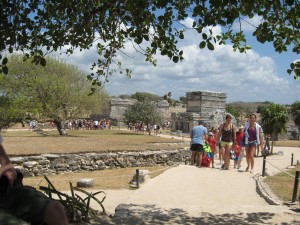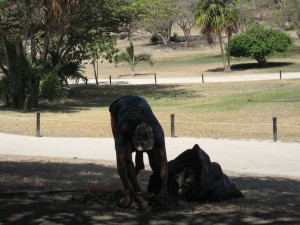In our reading of Wearing, Stevenson and Young’s chapter “Encountering the Other” from Tourist Cultures: Identity, Place and the Traveller (Sage, 2010), the authors remind us that “in developing nations the indigenous inhabitants are often used as servants by the tourism industry” (p. 57). They also argue that the tourist interaction with local cultures “expose[s] relationships of inequality that are grounded in race, culture and class. . .unveiling the often concealed power relationships that privilege individuals from the Western industrialized — touring — nations” (p. 61).
As I sat and watched the chaperoned crowds of tourists move through the site of Tulum, I realized that I saw no living Maya in this contemporary scene.
But wait…there were three: one man raking leaves into a garbage bag, and a man and woman who came to collect the plastic the first man had separated from the rest of his “trash” and then moved on.
Did any of the other tourists thronging this site see them? I think not, as one man from Italy walked over and stood on the corner of the garbage bag to get a better shot of the pyramid behind us. He didn’t even apologize for interfering with the Maya man’s work. These tourists, down for the day from Cancun, were inappropriately dressed for exploring an archaeological site in their bathing suits and sandals. Was it only my perception that these tourists seemed to be offended by the control their tour guides and the ropes on all the paths were attempting to exercise over their progress. If I spoke Mayan, I would have apologized to the man working next to me with the garbage bag for all of us who were invading this Heritage site that belonged to the workers in ways tourists can never really understand.




